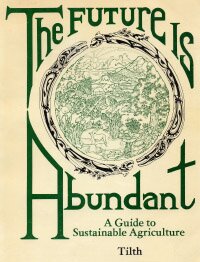
The Future is Abundant
A Guide to Sustainable Agriculture
Tilth Producers of Washington Home | WA Tilth Assoc. | Conference | Directory | Journal | Placement Service | Calendar | Action Alerts
Legislative Update | Bulletin Board | Classifieds | Questions on Agriculture? | Photo Gallery | Links | Contact Us | Join Now | Volunteer

Most people in the Northwest live in towns, cities and suburbs. We live in an industrial society cut off from the land and from the practice and traditions of agriculture. The widely touted figure of three per cent of the population on farms feeding the urbanized 97 per cent can be seen as either a mark of success or as a symptom of a culture out of balance. But attitudes are changing. In communities throughout the region there is a growing sense that neighborhoods can once again become exciting, productive places. Rather than clinging to a romantic notion that everyone can or should go "back to the land," many people share a new commitment to digging in right where they live, making their community a better place to live.
A simple inventory of any town, city or suburb would reveal acre upon acre of vacant lots, school lands, yards, roadsides, rooftops, and parklands, all with potential for productive community agriculture. Adding greenhouses, backyard chicken, rabbit, fish and bee culture, woodlots, fruit and nut forests, and food processing and storage facilities will greatly increase the ability of communities to sustain themselves.
Bringing food production into the backyard and the neighborhood has many advantages. First, gardens produce a wide variety of fresh foods right at home, with a minimum of outside energy inputs. And second, by re-integrating food production and distribution in our communities, we have the opportunity to achieve the closed nutrient cycles essential for sustained productivity. Wastes will be seen as a resource to be treasured rather than as a burden to be disposed of. As the beginning of this process, many community gardens have already established on-site composting systems, recycling all weed and crop residues for return to the soil. Several cities are also getting into the act through municipal composting programs.
In part because of the value of their manure, small livestock are becoming increasingly important components of backyard and neighborhood "farmsteads." Not only do chickens, quail, ducks and rabbits convert foods inedible by humans into high quality protein, but their manures add an additional source of fertility to the compost pile. Animal manure stimulates biological activity in the soil and contributes phosphorous and other essential nutrients.
As we overcome our cultural abhorrence of human wastes, a much greater integration of nutrient cycles will be possible. The resource most readily available in our own urine, which can become a valued source of fertility for the garden. In The Integral Urban House members of the Farallones Institute describe methods they have devised for utilizing urine safely and effectively. According to the Farallones book, each year "the average adult produces enough nitrogen in his or her urine to fertilize approximately fifteen hundred square feet of soil (a garden about forty feet by forty feet)." This is equivalent to the application of 300 pounds of nitrogen to an acre of soil. And, while the proper use of urine will enrich compost and feed soils, increased use of composting toilets will make it possible to recycle nutrient-rich human manure as fertilizer for trees and shrubs.
The percentage of a community's food that can be produced within its boundaries will vary greatly, but home and neighborhood production will become increasingly significant, especially for fresh vegetables, honey, fish and small livestock. At the same time, encouragement of public plantings of fruits, nuts and berries will greatly widen the sources of food available in every community.
It took a hefty volume to do it, but Resettling America unites in one volume 21 major essays on the movement toward community self-reliance. The book covers both urban and rural alternatives emerging across the country. Included is a lengthy analysis of Eugene's Whiteaker Neighborhood and original essays by Amory Lovins, William and Helga Olkowski, Peter Van Dresser, Murray Bookchin, and New Alchemist Earle Barnhart.
Resettling America is a textbook for students of the transformation now sweeping every aspect of our culture.
Detailed manual for the design of self-reliant houses and communities. Covers energy, urban gardening, livestock and fish production, and pest management. This book is filled with practical, down-to-earth information unavailable anywhere else. Well-researched and illustrated, The Integral Urban House is the best introduction to urban agriculture available.
Tilth Producers of Washington Home | WA Tilth Assoc. | Conference | Directory | Journal | Placement Service | Calendar | Action Alerts
Legislative Update | Bulletin Board | Classifieds | Questions on Agriculture? | Photo Gallery | Links | Contact Us | Join Now | Volunteer